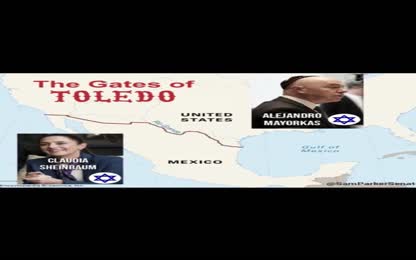Advertisement
PG & E Politics and crime
ABC 10 Fire Power Money Series
- Category: California Fires,Politics / Politician
- Duration: 20:18
- Date: 2021-08-19 18:33:36
- Tags: wildfires, politics, corruption
1 Comments
Video Transcript:
The employees of PG&E knew they ignored it. As a consequence, people died. The Pacific Gas and Electric Company ran a power grid so unsafe. It's criminal. Trying to stop sparking deadly fires, PG&E had to resort to cutting off the power when the wind blows. It's a giant bandaid to cover up their poor maintenance. About 16 million people have no choice but to buy their power from this company that's committed 91 felonies. They had lit the match on this bomb years ago and it wasn't if it's going to go, it's when it's going to go. After the campfire, PG&E promised to do better. We won't see you back at one of these? Sure. But more fires sparked, blamed on PG&E lines. They were supposed to be shutting off the power due to high winds. Their investigation reveals PG&E's deadly behavior and the political machine that allows it to keep going. This is fire power money. More than two years after the campfire, you can find signs of life on the ridge where burned. People rebuilding, individual perseverance, but as much as we love a good comeback story, that's not the big picture. In truth, when 85 people died here that day, this community died with them. Most of the tens of thousands of people who escaped aren't coming back. Herodice and its surrounding neighborhoods will have to be born again. I'm Brandon Ritteman. I was here in paradise to document the destruction that day and I've been investigating ever since. PG&E admitted to crimes for causing this fire and its under investigation for crimes again. Two more wildfires are blamed on PG&E's power lines. The grandmother of an eight year old girl who died in the Zog fire asked me why? Why is PG&E allowed to keep going like this after all it's already done? The answer comes down to power, not the electrical kind. We revealed that California politicians are still willing to take PG&E's money, even after the company admitted to the felony killing of 84 people here. The people who lost loved ones in the campfire live with a kind of grief few of us can understand. The deaths weren't just violent. They were caused by a crime. PG&E pleaded guilty to starting the fire and to killing 84 people. Prosecutors found evidence that PG&E repeatedly cut maintenance over the last three decades. These hooks wore down so much, one of them broke, dropping the power line into a metal tower and sparking the fire. The hook was 97 years old. They didn't want to spend the money to actually inspect these things. They didn't want to spend the money to actually replace these things. Despite PG&E's history of skimping on $10 hooks, there's one thing the company can't seem to stop spending on. I'm going to heat politics. State campaign finance records show PG&E donated $2.1 million of company money to California politicians and campaigns last year. This stack about a third of the donations is money PG&E gave while the company was still bankrupt. There's no law banning companies from making political donations during bankruptcy, but in PG&E's case, it doesn't look good, especially when you consider what the company did under chapter 11 protection. PG&E used its bankruptcy to argue it didn't have cash to pay fines for starting wildfires that killed more than 100 people. The campfire prosecutors say PG&E tried to offer them money during bankruptcy to avoid accountability for crimes. There was a number of offers for at a large money to say, do the civilly, don't charge them criminally. They were trying to use the bankruptcy to get out of being charged. Correct. But when time came to pay the victims of PG&E's wildfires, PG&E used bankruptcy once again to say it was broke. The victims were not only just victims, but then they were hostages. Former prosecutor Mike Aguire represents PG&E customers suing the state over the company's bailout. Instead of cash, he points out PG&E paid half its settlement to fire victims in shares of PG&E's stock. That means PG&E's fire victims took on the company's future risk. At the end of February, the stock in the victim's trust fund was worth $1.75 billion less than what fire victims were told in bankruptcy. It really wasn't to help the victims. It was to use the victims to justify bailing out PG&E. At the same time, PG&E was telling its victims it had no more cash to give, PG&E somehow found $60,000 to give to the Yes On Prop 13 campaign. A school bond package voters rejected in the spring primary. PG&E also spent hundreds of thousands more on political action committees that supported and opposed candidates in that primary. Later in the year, PG&E money started flowing directly to candidates, something we've seen before. PG&E was convicted of a federal of six federal felonies in 2016. After that, you took more than $200,000 to help get elected. How should people trust you to be running the show to come up with the solution? I wish you luck with whatever you're working on, but that's a strange question. Our reporting on the 2018 race revealed Governor Newsom and eight out of ten members of the state legislature took money from PG&E. They accepted that money even after a jury found the company guilty of six felonies for the deadly San Bruno gas explosion. Those elected officials then bailed PG&E out of bankruptcy with a law that created a multi-billion dollar wildfire fund paid for by customers. If PG&E is engaging in criminal contact that kills people in order to make money and you know that and then you accept their money, what does that make you? These politicians, the money they're taking is blood money and the justice guilty as PG&E is. The campfire added 85 more felonies to PG&E's rap sheet. 84 felony counts of manslaughter and one felony for sparking the fire. A few months after it was convicted of those crimes, PG&E started donating again. It's this second stack of money and it includes more than $100,000 PG&E gave to 17 current members of the legislature. Most are in Southern California, but these six represent districts in PG&E's monopoly territory. One who stands out, newly elected Bay Area Senator Dave Cortese. The other members took $2,500 a piece. PG&E spent $75,000 to help Cortese, not to his official campaign, but to Valley Neighborhoods United for Dave Cortese, a group made just to help him. Cortese, a Democrat, told us in a statement he had no knowledge of the donation and that he was shocked, shocked to learn that PG&E expended funds independently to support my efforts. We asked Cortese if he was willing to disavow the donation that PG&E made in his name. We didn't hear back. Senator Steve Glazer also took money from PG&E last year, which is odd considering the Democrat returned some of his PG&E money in 2018. What changed? His office didn't reply to our emails asking. All their donations helped them get away with murder. You don't give somebody $8,000. Some minor little state Senator $8,000 and expect nothing for it. I mean, that's ridiculous. They bought influence. Of the 17 lawmakers, only one told us they parted ways with PG&E's donation. Top Senate Democrat Tony Atkins' staff told us an unsolicited contribution from PG&E was received and it has since been returned. Republicans and Democrats accepted PG&E money after the company admitted to killing people here, so did the campaigns for several controversial ballot questions. You can browse all of PG&E's donations at firepowermoney.com. What PG&E did was violent. Whether you beat someone to death or you cause them to die in a fire, you caused a violent death. The violence of the campfire turned main street businesses to ashes. It destroyed the homes of 14,000 families and killed at least 84 innocent people. The employees of PG&E knew. They knew. They ignored it. As a consequence, people died. PG&E's maintenance of its power line wasn't just bad. It was criminal. The company pleaded guilty to 84 felony counts of manslaughter. Nearly every building in Paradise burned down in the span of a few hours. But PG&E's criminal behavior took place over years. They had lit the match on this bomb years ago and it wasn't. If it's going to go, it's when it's going to go. What went was this nearly 100 year old worn down hook, which cracked, dropping the powerline it was holding and sparking the fire. PG&E's decision was simply just to let these things hang until they broke. What did PG&E know and when did PG&E know it? Much of the evidence used to indict PG&E has remained a secret, shown only to the grand jury. Until now, we obtained this internal PG&E report that found the same kind of wear on other old PG&E power lines. It shows PG&E knew it had this problem with old parts and that PG&E wasn't keeping track of how old those parts were. Your colleague had to guess how old this stuff was. Yeah, we find that a lot. These photos taken by PG&E showed the company taking part in its own criminal investigation. Literally, we're letting the murderer into the crime scene and telling them to collect our evidence for us. Prosecutors couldn't find a qualified contractor willing to pull parts off the powerline that sparked the campfire, so PG&E's own crews did the work and the company catalogued every piece of evidence it helped collect. This hook found a couple miles up the line from where the campfire started shows just how bad things got. A groove more than halfway through the metal from decades of grinding against the hole it hung from. Those holes in what are called hanger plates or wear plates also became evidence. On this side, this hole is worn, what we call keyhole in. These holes started as perfect circles, but over time got worn down by the hook. We found evidence that before the campfire, PG&E knew old parts like these were wearing past their useful lives. These worn plates showed up in a PG&E lab report, half a year before the campfire started. The photos show the hooks had worn more than halfway through the metal of the plates. Plates PG&E crews found hanging here. On this high tension line near the Caldacot tunnel in the Bay Area. These plates hadn't been changed in 72 years. At least that's the best guess the engineers at PG&E's lab could make, that these plates were probably installed in 1946. What would it have been like trying to figure out how old those plates were when they walked into the lab? Oh, you wouldn't know. Engineer Nick Bantz did not write this report. He was one of a handful of metallurgists working in the PG&E lab that created it. And he said PG&E had no good database for these parts. Puts, plates, things like that. I don't think there's records of any of those anywhere that I'm ever aware of. PG&E's lab report shows company scientists had to guess how old parts were using the year the tower was built. 1946. They know the age of the towers, but they weren't tracking the age of the parts. Exactly. The campfire prosecutors found the same thing on the power line that burned down paradise. PG&E had no records to show how old the parts were. This line was energized in 1921 and then they have nothing until 1990. Prosecutors say PG&E had a simple reason not to track the age of parts. The company wasn't interested in fixing them. The term that all of the PG&E people run away from is run to failure. Running to failure means not fixing a machine until it stops working. And PG&E's machine carries hundreds of thousands of volts through the air. Running to failure, it's like running around with a loaded gun. Former State Utilities Commissioner Catherine Sandivall says the fact that PG&E let parts get this worn down should worry all of us. And the world that PG&E created reflects their criminal thinking and is criminally reckless. PG&E denied that it used to run to failure strategy in writing to a federal judge. But prosecutors aren't alone saying the company used to run to failure policy. So does a former PG&E engineer. That was talked about as company policy. I thought that I didn't know if that wasn't publicly, but I mean, run to failure was the policy. Did they call it that? That's what it was joke about. Pretty much run to failure. And it wasn't that big of a deal before really the wildfire time. Wildfire danger has, in fact, gotten worse in the last decade. PG&E frequently points to climate change as the main problem. The federal judge handling PG&E's probation is all out of patience with that. Please don't blame climate change. Judge William Al subscoulded PG&E's lawyers. Climate change doesn't start the wildfire. PG&E starts the wildfire. This report on Warren Parts is also evidence of how PG&E looks at this problem. There is no remaining life to that. In his opinion as a metallurgist, Nick Bantz told us PG&E was already on borrowed time with these hanger plates. And yet, the report claimed those plates could last another 28 years. I think it's trash in my opinion to even have stated it. The lab report says it ignored the possibility these plates could crack, assuming that they'd just keep wearing evenly all the way through. But Nick says they were already at risk of cracking. This could have fell anytime in the last decade. That's what happened to the hooks holding up the power line that sparked the campfire. On this one, the actual hook that caused paradise to burn down, you can see just that tiniest bit of a nub. We wanted to know why PG&E's lab report tried to estimate remaining life for used up parts. The engineer Peter Martin authored that report. He now works at the Rochester Institute of Technology in New York. Martin didn't respond to our calls and emails. We do know he's trying to keep his name off of the record of PG&E's crimes. And so is this whole list of PG&E employees. In a lawsuit paid for by PG&E, asking a court to black their names out of the grand jury transcript. We obtained all 22 names on that list. It includes all four people listed on the PG&E lab report. They're keeping quiet, but Nick has an idea of why his lab tried to say these parts did have some remaining life to give somebody a number for something because they were wanting a number. A number Nick says PG&E's power line managers kept asking for. Without those managers, PG&E's lab couldn't earn billable hours of work. So he says the lab gave those managers what they asked for. That had to do with pressure on the scientists to deliver what they were looking for. Correct. It's completely backwards. Sandeball says the fact that PG&E set up a lab that had to sell its own services to managers within PG&E is more evidence of the company relying on criminal thinking. That is not the responsibility of some guy to convince, to convince another boss to send them work. It is PG&E's responsibility as the corporation that owns those assets, maintains those assets. Prosecutors say PG&E missed these problems because it cut back on maintenance and inspections. The company even admitted that it tied bonuses to how well supervisors cut inspection costs. PG&E told the judge it doesn't do that anymore. The more I study about what happened, the more galling it is. They knew that these hooks were failing. To this day, Phil Benstock still wonders how painful his father's death was. His first check for his dad's death finally arrived. $25,000 minus attorney's fees. He told us he'd much rather see PG&E's upper management in prison. If I had a sense that they were even trying to fix anything in a really meaningful way, maybe I wouldn't feel so harshly towards them, but... evil little people. Just three months after PG&E pleaded guilty to burning down paradise, the Zogfire killed four people, including an eight-year-old girl, Phala MacLeod and her mom, Alaina. In 45 minutes, my entire life would like that. The Zogfire is blamed on a pine tree. PG&E contractors had marked as needing to be removed, but never actually cut down. California law requires power companies to cut trees that threaten their lines. PG&E is on federal probation for crimes that committed back in San Bruno eight years before the campfire. The judge handling PG&E's probation is pushing the company to keep better track of its safety work and to do a better job targeting shutoffs, where the most danger from trees exists. He's not the only one investigating. Chastik County prosecutors say criminal charges are possible, charges that could be as serious as murder. We can't stop every fire, but we can stop these. Until that happens, we'll keep investigating the root causes of this crisis. Fire, power, money.










 Donate
Donate







